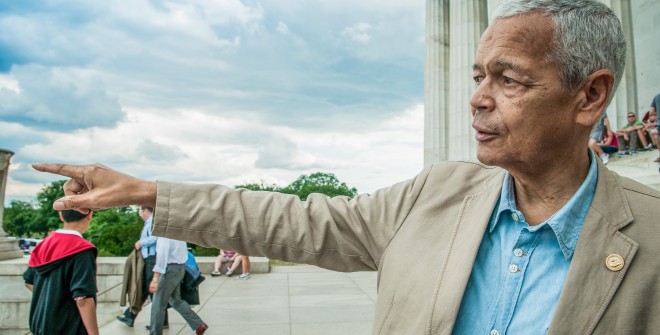Julian Bond. Photo: Courtesy Virginia Film Festival, 2012
Since 1996, the Barbara Jordan Forum has been a means of honoring its namesake, a celebrated Texas politician and a beloved former LBJ professor. As a kick-off to this year’s program back in February, civil rights activist Julian Bond delivered a keynote address to a packed auditorium of about 800 attendees, including middle and high school students from the greater Austin community. His speech, and the problems they address, merit attention well after Black History month.
Mr. Bond’s illustrious background includes co-founding the Student Nonviolent Coordinating Committee (SNCC) and being elected to the Georgia House of Representatives in 1965. These facts are easy to find online or in some textbook but they don’t capture his presence or sense of humor. He spoke about the history and mood during the Civil Rights Movement, adding a personal touch as he recalled his friendship with Martin Luther King, Jr. and his first arrest at a segregated cafeteria in Atlanta’s City Hall. “Dr. King only taught one time. Only taught one class. Only eight people in the class. I’m one of the eight.”
He emphasized that while great strides have been made for equality within the United States, the past is not dead. We do not live in a post-racial society. He reminded the audience that President Obama’s election “was a testament to one man’s singular abilities and not to racial nirvana across the land.” The reality of racism, whether intentional or not, is evident in countless facets of American society, including classrooms and the justice system. This reality should lead us to reconsider Mr. Giuliani’s comments questioning the President’s love for this country.
Reflecting on Mr. Bond’s keynote, I am left with a few reflections. The underlying tone of his speech was that there is work to be done. This is certainly true at the LBJ School and, undoubtedly, other institutions of higher education. I had the chance, along with several other students, to have breakfast with Mr. Bond before he gave his keynote address. As he greeted each of us he made an observation and asked “Where are the men?” I have also had a similar thought: Where are the men of color? And on that note, what can be done to increase overall diversity of the LBJ School? What steps are being taken to make the School a more inclusive community?
While increasing funding and financial support could contribute to a larger number of students of color, the issue is larger than university education. Communities of color face a unique set of obstacles – such as a high rate of incarceration and exposure to policy brutality for African-American men – that limits their access basic rights such as education. As a friend of mine asked: How can we expect communities of color to grow stronger and overcome the obstacles set before them if men of color are not involved? Since “what starts here changes the world”, according to the University of Texas, the LBJ School should recruit qualified students of color so that they can begin changing the world for communities of color. With a more inclusive community, we would gain greater exposure to a variety of perspectives and opinions, which is missing within the realm of white majority academia.
It is important that discussions about inequality, race, and diversity continue even after the Barbara Jordan Forum and Black History Month. In the spirit of the Forum, student organizations such as the Public Affairs Alliance for Communities of Color and the Feminist Policy Alliance planned events on diversifying the vote, the importance of women in politics, and partisanship. As student groups continue to work for more diversity, I look forward to when the LBJ School makes more room for these issues within the curriculum and the classroom. In order for that to happen, a more diverse faculty who can implement issues of race within their curriculum is also necessary.
Mr. Bond’s appeal to millennials to fight for change leads to my final thought. During his speech, he mentioned several statistics: the infant mortality rate is 134% higher for blacks; blacks are 33% less likely to have health insurance; and the wealth gap between blacks and whites continues to increase. I will leave you with this question: How can we use what we learn as students of public policy to fight inequality and help marginalized communities? The keynote address encouraged me to promote change where I already am- the LBJ School and the City of Austin. Personally, it is my goal to become more involved with community outreach efforts in the city. While learning theory and discussing issues of race in an academic environment is valuable, change happens when we step outside of the classroom.
Edited by Jon Brandt

